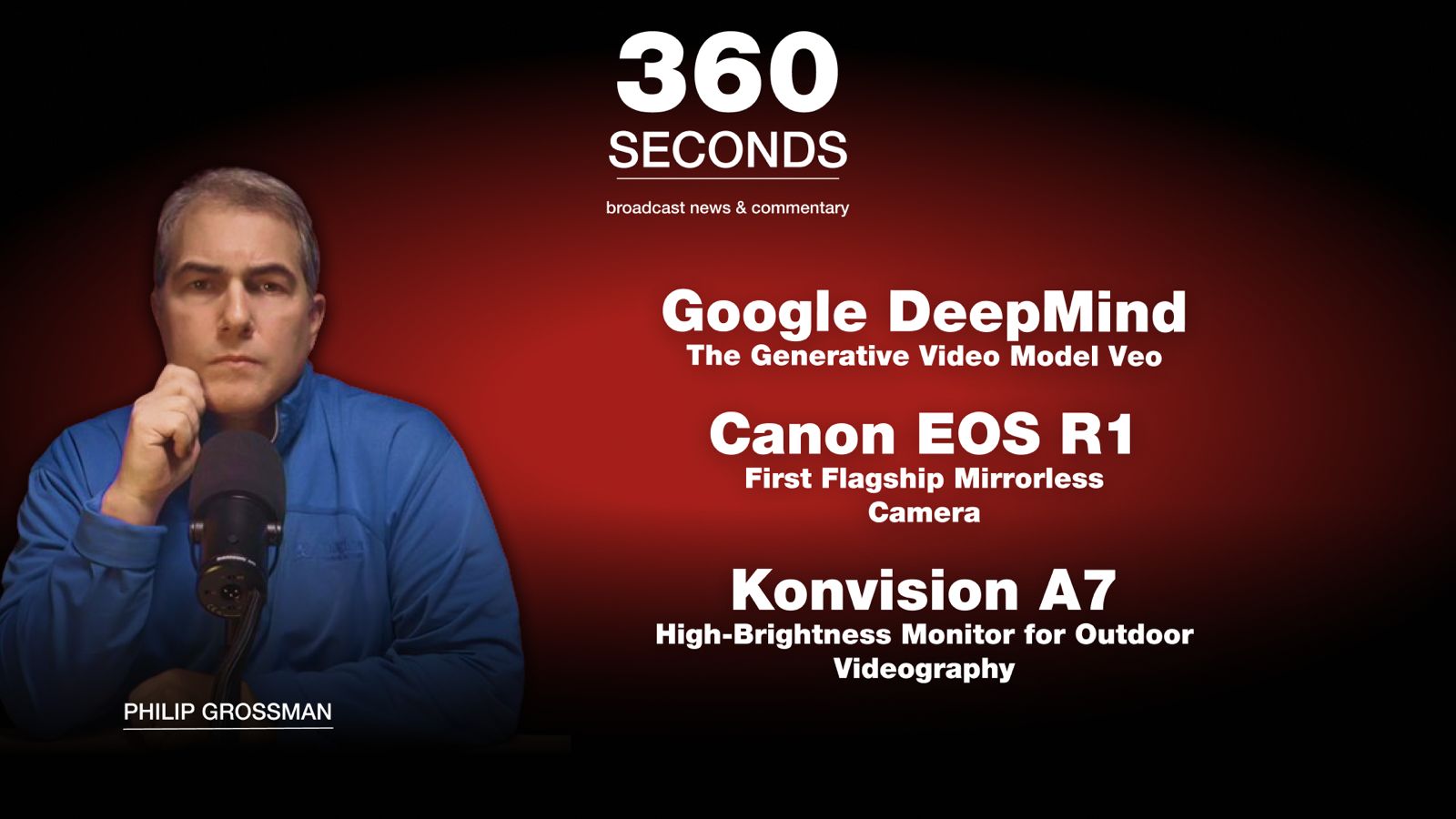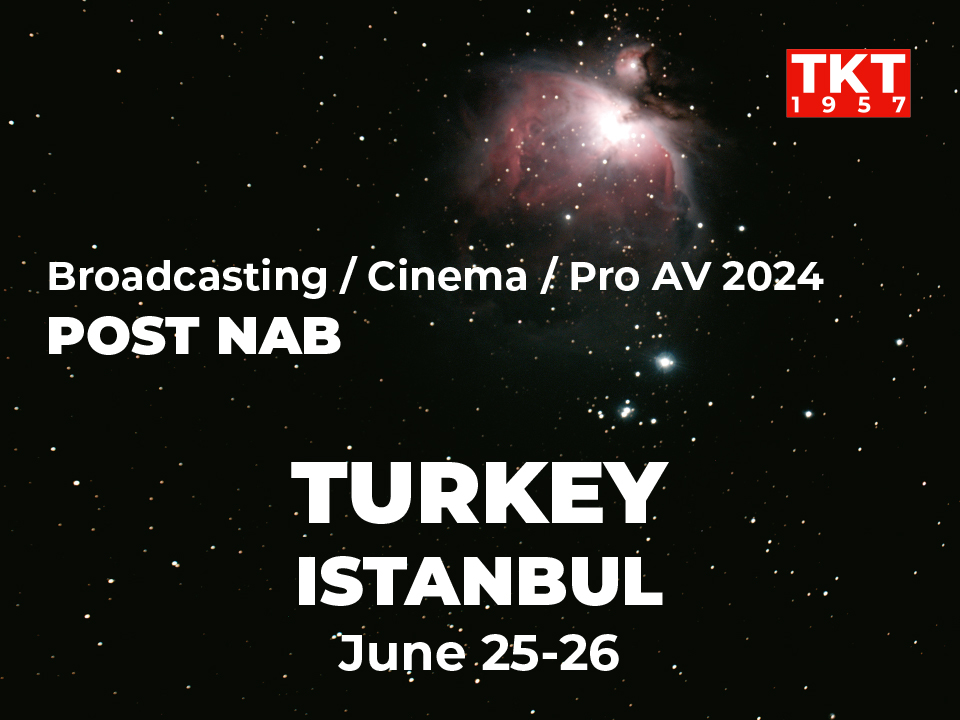
-
Google DeepMind released the generative video model Veo
-
Konvision A7S: High-Brightness Monitor for Outdoor Videography
-
Canon’s First Flagship Mirrorless Camera EOS R1 in Development
360 Seconds. Broadcast News & Commentary is a weekly program on Youtube about the latest equipment for broadcasting and film. Explained by experts – practitioners directly working in the field of cinema and television.
Hosts: Philip Grossman, host and co-producer at Visionaries, and Mark Sindyukov, and Pax Moore. Production – TKT1957 LLC.
Airing on May 22, 2024
Google DeepMind released the generative video model Veo
Mark: Google DeepMind released the generative video model Veo. Philip, Veo is our most capable video generation model to date. It generates high-quality, 1080p resolution videos that can go beyond a minute, in a wide range of cinematic and visual styles. Do you mind sharing with us what are your thoughts about this?
Philip: The AI technology as a whole and on the industry and how it could affect jobs…sure, AI for me, I think jokingly, you refer to it as algorithmic imitation. It’s generating new stuff, but only based on things it’s been trained on. I think it’s a great tool, and we’re seeing more and more capabilities, but like anything else, people will abuse it, it’ll get overused. And then, of course, the biggest one is copyright—who trained it? So, the question always becomes, is it, in theory, whatever it has generated is based on something somebody else has created.
Now, all that aside, I think in general, generative AI in video has a fantastic role for visualization and storyboarding. It enables you to really create something other than just a drawing on the screen that somebody has to sort of “okay, I sort of get what you’re saying in the conversation or you know about what kind of program you want to build.” This just takes it to that next level, where when you’re dealing with financiers or a studio or just your team in general, it helps get that thought across.
I think the bigger issue is people wanting to just generate content from the ground up for this and distribute it. Is it going to be of much value? No, it’ll be neat, you’ll see a lot—I mean, the first music video came out not too long ago, it was interesting, but it was monotonous to be quite honest, the same thing over and over again. You know, I think that the best line I’ve heard from one of my friends is, “You’re not going to be replaced by AI; you’re going to be replaced by a person who uses AI,” and I think that’s true with any tool.
My biggest concern, I think in the industry around the AI movement is, let’s take an example: you’re an assistant editor, your main job is to collate potential shots and then when you show them to the editor, the editor goes, “Oh no, this isn’t very good because of X,” or “This is great because of Y,” and so you learn. Well now, if I can train AI to sort of pick the shots for me, what happens to that assistant editor? That assistant editor doesn’t exist anymore; that assistant editor cannot become a lead editor. So there’s a potential for disruption in this artistic industry—a disruption in that artistic length or that artistic input and the next generation of editors. Things may become very robotic. I think AI is great if used right, but like anything else, you know what they say, “With great power comes great responsibility.”
Mark: Another question I have just as a follow-up is: How would you recommend young individuals who are coming into the professional field right now focus, especially those with up to five years of work experience? How should they integrate their AI application?
Philip: Right, so I think it’s important that they learn how to use the tools, like anything else. If you’re going to become an editor, learn how to use the editing tools. Now, I think the big issue is always around, you know, “Oh, I only know how to use Premiere, or I only know how to use Resolve, or I only know how to use Final Cut.” They’re all tools. Now, you can become an expert in tools, but as a young professional, you want to really expose yourself to a lot of the different tools and make sure you understand how they all work.
And I think it’s the same for AI. Start to understand the value of the human in the AI chain and sort of exploit that as a young professional, figuring out how you can use this to speed up the process, help you do your job better, just like any other tool. But you don’t want to get lazy and go, “Well, I could edit this, but I’m just going to use the AI and let it do all the editing for me.” I think that’s like anything else; you have to be careful that you don’t become lazy because of the tools.
Konvision A7S: High-Brightness Monitor for Outdoor Videography
Mark: Now, going into the next piece of news I wanted to talk to you about: we have the outdoor videography high brightness monitor by Konvision, a Chinese manufacturer known for its broadcasting video equipment since 2009. They have introduced the A7S, a new 7-inch touchscreen monitor that supports 4K60p recording and boasts a high brightness level of 1500 nits. This is an interesting solution, Philip, what are your impressions of this one?
Philip: You know, there are a lot of 7-inch monitors coming out, and I think it’s great—the more tools I have to choose from, the better. The big issue is how you differentiate. In their world, it seems that they’re differentiated because they’re also a recorder, which is great. They do ProRes, which is pretty much a standard. I don’t know if it’ll be the primary record module on set, but it’s perfect for backup and for those who maybe don’t have a camera that can record in ProRes, recording say H.264 or H.265, which are a little more compressed. This gives them an additional tool to use.
Konvision A7S: High-Brightness Monitor for Outdoor Videography
I think the high brightness is fantastic. I tend to think that people push the color accuracy of these little monitors a little further than they need to. Now, if you are shooting on set and you’re shooting in ProRes, the color accuracy helps a little bit because you have a better understanding. If you’re shooting RAW on a RED, an ARRI, or Blackmagic, the need for color accuracy sort of goes away because you are capturing in RAW, so you have a lot more latitude. But it’s always nice to be close, and I think touting that extra color accuracy is a good thing. The brightness is great. The only thing I don’t know about is the cost. I would assume it’s going to be relatively low as we have more and more of these panels coming out, which I think is great, especially for new filmmakers to be able to get a hold of a tool like this that’ll help them.
Mark: So fantastic, I appreciate your responses. We’re now going to transition to the next topic of discussion that will be introduced by my co-host, Pax.
Canon’s First Flagship Mirrorless Camera EOS R1 in Development
Pax: With the breaking news, according to Canon, the EOS R1 will “dramatically improve the performance of both still images and video, in comparison to the EOS R3, and meet the high requirements of professionals on the frontlines of various fields including sports, news reporting, and video production.” A couple of questions for you, Philip: Who would benefit the most from it, and how do you feel, just in comparison to the price point of the EOS R3, will it be worth it or not?
Philip: Unfortunately, we don’t have a lot of details, although we know that the R1 is typically Canon’s flagship camera. They’re launching it and announcing it in conjunction with the Summer Olympic Games. Knowing how Canon works, I would suspect it’s going to have some groundbreaking technology in it. I’m sure we’ll hear the word AI show up every once in a while. What’s really going to be most interesting for me is whether they are moving to a global shutter. We’ve seen this with Sony recently and, of course, the RED cinema cameras have all moved to global shutters as opposed to rolling shutters, which is really a necessity nowadays for fast-moving sports action when you’re doing video.
What we’re finding is a lot of stills photographers are being asked to capture more video. The reality is if I’m capturing 8K at 30 frames a second, that’s 35 megapixels per frame, so I can actually pull a still from that. The target audience is definitely going to be professionals for this camera. It’s probably going to be priced at about that level as well, around $7,999, which is typically where that camera gets priced at. It will have longer record times. I’m hoping that they have sort of learned their lesson from the initial R5, which really had some overheating issues because of the way it was designed. Not necessarily a fault of Canon, but it was a new camera, new technology. This one’s going to be very focused on sports, high frame rates. I would suspect it’s going to be in that 45 to 60 megapixel range for the stills image. It will record 8K, I can almost guarantee it since the R5 records 8K. It will do it in RAW. The big question is whether they will have a global shutter. If they do, then I think it becomes a real game-changer in terms of the professional SLR/hybrid video market. So, it could be very interesting what they bring out. I’m excited—I’m a Canon shooter, I’ve been shooting Canon for over 20 years. Always excited when they bring out their flagship camera because it also signals the tech that will eventually make it down into the R3 Mark I, the R5 Mark I, and down the pipe.
Pax: Would you see yourself actually acquiring this camera, and if you did, what would be the first project that you would see yourself using it on, if you had anything in mind?
Philip: So it’s a potential—if it has a global shutter in it for video, no doubt about it, I would purchase the camera. If it does not, the additional megapixels for me aren’t that much—I’m not necessarily a sports shooter, so the high shutter speeds, or the high frame rates as you say, and the autofocus are all wonderful technology, but they just don’t necessarily do much more than what I need it to do. But I can tell you, if it does have a global shutter, then it’s going to become my all-around camera. For example, I’m going to shoot an air show this weekend. If I had this camera and it had a global shutter, I would be taking one camera to the show and capturing both stills and motion. I tend to try and do that today with my R5, but unfortunately, the rolling shutter on fast-moving objects does show itself as a weakness.
Canon always has a unique issue with its cinema line as well—if they put too much of the cinema tech into a stills camera, do they cannibalize that industry? Unfortunately, the way Japanese companies tend to be set up is that they compete with one another, so the cinema group is not necessarily going to give the tech to the stills group and vice versa. I wish it wasn’t that way, but that’s just the industry we live in.
Canon’s First Flagship Mirrorless Camera EOS R1 in Development
Pax: Thanks to the experts for watching, thank you to Philip Grossman for taking the time to speak with us and, of course, give us his opinion and expertise on the new upcoming tech. We’ll see you next Monday at the same time!
360 Seconds. Broadcast News & Commentary
The weekly show, focusing on the latest products and solutions in the global TV and film industry, features insights and analysis from top experts. Released every Monday within the TKT1957 network, the program can be found on the YouTube channel, social media groups, and the tkt1957.com website.
“360 Seconds. Broadcast News & Commentary” is versatile and offers a wide range of formats to captivate our audience. Here are some of the key elements you can expect in our productions:
Live Streaming: We host weekly live broadcasts, allowing our presenters to interact with the audience in real-time. This enables us to answer questions, engage with comments, and delve deeper into trending topics.
Interviews: We invite experts, influencers, and colorful personalities to share their insightful insights and experiences on a wide range of topics.
Provocative Discussions: Our content sparks thoughtful discussions that address current events and trending topics. We promote constructive dialogue among our viewers.
Product Reviews: We provide candid and unbiased reviews of various film and broadcast products and services, enabling our audience to make informed decisions.
We highly value the opinions of our viewers and actively encourage their participation in our programs. Feel free to chat with us during broadcasts, comment on our videos, and suggest topics or guests you’d like to see in our productions.
Our programs follow a consistent release schedule, with new content debuting every Monday. Don’t forget to subscribe to our channel and turn on notifications so you never miss an episode!
The program can be watched every Monday at 11:00 am ET by clicking on any of these links:
Engage with the content, view the episodes, and participate in the conversation by leaving your questions in the comments section!





